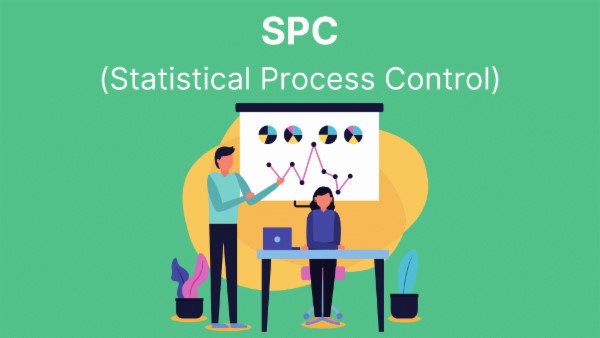Statistical Process Control (SPC) is crucial in modern manufacturing due to its profound impact on quality control and process efficiency. This methodology allows manufacturers to achieve higher levels of product quality through the systematic monitoring of production processes. By employing SPC, companies can detect deviations from production standards early. This prevents the occurrence of defects that lead to waste and increased production costs.
SPC’s role extends beyond mere defect detection; it fosters a culture of continuous improvement and data-driven decision-making. Manufacturers that implement SPC can swiftly respond to process variability, identify the root causes of fluctuations, and address them proactively. This not only enhances the reliability of manufacturing outputs but also optimizes the use of resources. This prevents wasting materials, time, and labor on producing substandard products.
Moreover, the adoption of SPC in manufacturing helps maintain compliance with industry standards and regulations. In industries where quality regulations are strict, such as pharmaceuticals, automotive, and food and beverage, SPC becomes indispensable. It ensures that products consistently meet stringent quality criteria, thus safeguarding consumer safety and trust.
The integration of statistical process control into modern manufacturing practices is not just beneficial. It’s necessary for companies aiming to maintain competitive edges. It also helps with regulatory compliance and meeting the quality expectations of their customers. It leads to improved product quality, reduced waste, and more efficient production processes. This are all key drivers of business success in today’s market landscape.
Understanding Statistical Process Control
Manufacturers primarily use Statistical Process Control (SPC) as a methodological approach. It’s purpose is to monitor, control, and optimize processes through the use of statistical methods. Understanding SPC begins with recognizing its foundation on the principle of variation management. Identifying, quantifying, and controlling variability in manufacturing processes to ensure consistent output quality.
At the heart of SPC is the use of control charts. These are fundamental tools that provide a visual representation of data over time. They track whether a process remains within predetermined control limits. Setting these limits at three standard deviations from the process mean in both directions signifies the boundary where one considers the process variation normal or expected. Any data points that fall outside these limits indicate that the process may be out of control. This suggests the presence of special-cause variation as opposed to common-cause variation, which is inherent in the system.
SPC involves not only the monitoring of process outputs but also a deep understanding of the process itself. It requires knowledge of the factors that could potentially influence the results. This enables operators to distinguish between random fluctuations and meaningful deviations that call for action. This differentiation is crucial as it prevents over-adjustment of processes based on random noise, thereby enhancing process stability and predictiveness.
Educating Employees
Proper training and workforce engagement are crucial for successfully implementing SPC. Managers must educate employees on how to effectively use SPC tools. They must also know how to interpret the data presented by control charts and understand their role in maintaining process control. This education ensures that SPC can be a collective effort involving everyone in the company. This includes the shop floor workers to senior management. This fosters a culture of quality and continuous improvement.
Ultimately, understanding SPC is about recognizing its value as a proactive quality assurance tool. It’s not just about detecting problems after they have occurred but about preventing them through continuous monitoring and adjustment. This proactive approach helps manufacturers achieve higher quality, efficiency, and customer satisfaction. This makes SPC an indispensable element of modern manufacturing systems.
Implementing Statistical Process Control
Implementing Statistical Process Control (SPC) in a manufacturing environment requires careful planning. It also requires a commitment from all levels of the organization and a thorough understanding of the processes to be monitored. The implementation process typically starts with defining the scope of application. This involves identifying critical processes and quality characteristics that are vital to the production outcomes and have a significant impact on customer satisfaction.
The next step is to gather accurate and relevant data. This involves setting up measurement systems and ensuring they are capable of providing reliable and precise data. Data integrity is paramount in SPC because the decisions and actions derived from analysis will only be as good as the data input. Calibration and maintenance of measurement instruments, along with training for personnel on how to correctly collect and handle data, are crucial elements at this stage.
Once data collection is established, developing control charts is the next step. These charts are used to visualize the data over time. They help to see whether processes are under control or if there are any signs of unaccounted variance. Setting the control limits accurately—usually at plus or minus three standard deviations from the process mean—helps in distinguishing common cause variations from special causes that require corrective actions.
Continuous Improvement
To effectively implement SPC, it’s also essential to foster an organizational culture that supports continuous improvement and data-driven decision-making. This cultural shift can be facilitated by training and empowering employees to understand and use SPC tools in their daily work. Regular training sessions, workshops, and real-time problem-solving teams can help embed these practices into the organizational fabric.
Finally, for SPC to be sustainable, it must be continuously monitored and adapted. This includes regular reviews of control charts, reassessment of control limits, and refinement of data collection methods as necessary. Management should also regularly review the effectiveness of SPC implementations, making adjustments to ensure that the benefits of SPC—such as reduced variability and improved product quality—are fully realized.
In conclusion, implementing SPC is not a one-time project but a continuous journey of improvement. It requires technical setup, educational initiatives, cultural shifts, and ongoing management commitment to be successful.
Benefits of Statistical Process Control
Statistical Process Control (SPC) offers a multitude of benefits that can significantly enhance the efficiency and quality of manufacturing processes. One of the primary advantages of implementing SPC is its ability to provide a clear, objective view of process performance using statistical methods. This clarity helps in identifying process variations—distinguishing between normal process noise and variations that signal a problem needing intervention. By focusing on reducing variation, SPC enhances the consistency and predictability of output, which is crucial for maintaining high-quality standards.
Another significant benefit of SPC is its role in reducing waste and scrap in manufacturing processes. By catching variations and potential defects early in the production cycle, companies can avoid the costly consequences of allowing defective products to continue through to completion. This not only saves on raw materials and energy but also reduces the labor and time that would otherwise be spent on reworking or scrapping defective items. Consequently, SPC contributes to more sustainable production practices and better resource utilization.
Furthermore, SPC empowers businesses to make better-informed decisions based on data-driven insights. This capability enhances proactive management and continuous improvement, as teams can adjust processes in real-time before issues become costly or damaging. It also supports root cause analysis, allowing teams to delve deeper into why variations occur and to implement effective solutions to prevent recurrence.
Regulatory Compliance
In industries where compliance with quality standards and regulations is mandatory, SPC helps ensure adherence to such requirements. Regulatory bodies often recognize the value of statistical quality control methods in maintaining standards. Thus, implementing SPC can facilitate smoother compliance processes and help avoid penalties associated with non-conformity.
Moreover, the benefits of SPC extend to enhancing customer satisfaction. By consistently meeting quality expectations, companies can build stronger, more reliable relationships with their customers. Higher quality products result in fewer complaints and returns, which directly impacts customer loyalty and the overall reputation of the business in the marketplace.
In summary, Statistical Process Control is a powerful tool that offers substantial benefits across various aspects of production and quality management. By integrating SPC into their operations, manufacturers can achieve more stable processes, reduce costs, improve quality, ensure compliance, and ultimately enhance customer satisfaction. These improvements are essential for maintaining competitive advantage in today’s fast-paced market environments.
Challenges in Applying SPC
Applying Statistical Process Control (SPC) effectively in manufacturing environments comes with its own set of challenges that organizations must navigate. One of the primary hurdles is the requirement for precise data collection and management. SPC relies heavily on accurate, consistent data to produce meaningful insights. Errors in data collection, whether from faulty measurement instruments, human error, or inadequate data handling procedures, can lead to incorrect analyses and decisions that may adversely affect the production process.
Another significant challenge is the need for comprehensive training and culture change within the organization. SPC is not just a set of tools but a philosophy of continuous improvement and quality control. For SPC to be effectively implemented, employees at all levels must understand its principles and how to apply them in their daily work. This requires ongoing education and sometimes a shift in mindset from a reactive to a proactive approach to quality control. Without sufficient buy-in from the workforce, SPC initiatives can struggle to gain traction.
Furthermore, the initial setup and integration of SPC into existing processes can be complex and resource-intensive. It often involves overhauling current systems, which can disrupt production lines and require significant time and financial investment. The complexity increases in environments where processes are highly variable or where there are many interdependent steps that complicate the identification of key variables and control points.
Continuous Engagement
Moreover, maintaining the momentum of SPC practices over time can be challenging. Once the immediate benefits are realized, organizations may become complacent, reducing the rigor with which SPC procedures are followed. Continuous engagement and motivation from management are necessary to sustain the benefits of SPC and to encourage an ongoing commitment to quality and improvement.
Lastly, adapting SPC to rapidly changing production technologies and markets presents another challenge. As new technologies and processes are adopted, the SPC system itself may need to evolve to accommodate new data types, production speeds, and variability. Keeping the SPC system aligned with technological advancements and market demands requires a dynamic approach to process control and continuous system evaluation.
Overcoming these challenges requires a strategic approach that includes strong leadership support, effective training programs, robust technology infrastructure, and a persistent focus on quality and continuous improvement. By addressing these challenges head-on, organizations can fully leverage the power of Statistical Process Control to enhance their operational efficiency and product quality.
Conclusion
Statistical process control is an invaluable tool for maintaining quality and efficiency in manufacturing processes. By providing a systematic approach to monitoring and improving processes, SPC helps companies reduce variability, improve product quality, and optimize their operations. Although there are challenges in implementing and maintaining SPC, the benefits far outweigh these obstacles, making it a vital component of modern manufacturing strategies.



